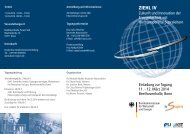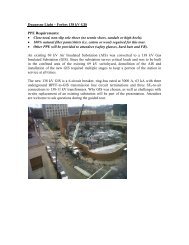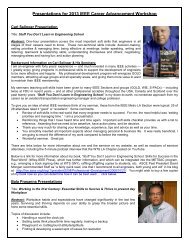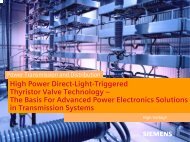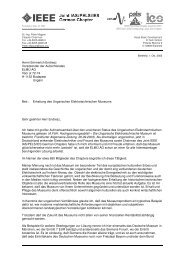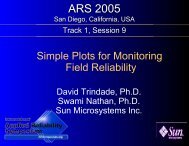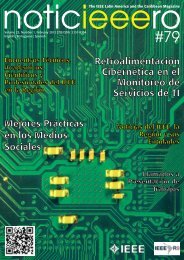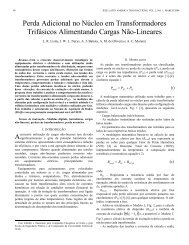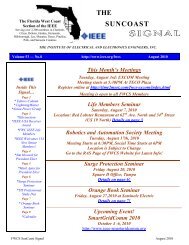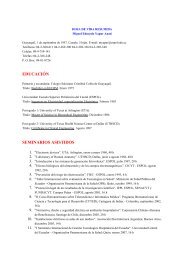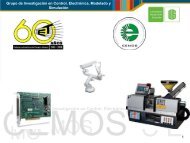Product Safety Newsletter
Product Safety Newsletter
Product Safety Newsletter
Create successful ePaper yourself
Turn your PDF publications into a flip-book with our unique Google optimized e-Paper software.
The<br />
<strong>Product</strong><br />
<strong>Safety</strong><br />
<strong>Newsletter</strong><br />
Vol. 9, No. 4 October - December, 1996<br />
Chairman’s Message<br />
What’s Inside<br />
Chairman’s Message .................................. 1<br />
Officers of the PSTC’s .............................. 2<br />
Area Activities ........................................... 3<br />
News and Notes ......................................... 4<br />
<strong>Safety</strong> Net — News from the Internet ...... 6<br />
Technically Speaking ................................ 8<br />
Acceptability of <strong>Safety</strong> Risks .................. 12<br />
Institutional Listings ................................ 22<br />
Standards: Beauty or the Beast<br />
The semiconductor<br />
equipment<br />
industry is performing<br />
a major revision<br />
of its basic product<br />
safety standard, SEMI<br />
S2-93, <strong>Safety</strong> Guidelines<br />
for Semiconductor<br />
Manufacturing Equipment.<br />
The first order of<br />
Brian Claes<br />
business has been to<br />
decide on the basic nature of the revised standard.<br />
Should it remain largely principle- and performance-based<br />
or expanded to include a range of<br />
prescriptive requirements? The considerable majority<br />
of those participating in its revision adamantly<br />
affirm that it should remain a compact,<br />
high-level performance document. Curiously,<br />
however, as work proceeds the actual text that is<br />
being generated is growing like a cancer with more<br />
and more prescriptive requirements being added.<br />
The frustration of watching an exemplary standard<br />
deteriorate into a collection of prescriptive requirements<br />
drove me to ponder the whole matter of how<br />
product safety standards are generated and revised.<br />
Remember UL 478, <strong>Safety</strong> of Electronic Data Processing<br />
Equipment? In 1980, the fourth edition of<br />
UL 478 was barely 50 pages of not very compact<br />
prescriptive requirements. Its current successor,<br />
UL 1950 (third edition) is now 260+ pages long,<br />
with a bright future of future expansion. What’s<br />
been the benefit of this requirements explosion?<br />
Continued on Page 4<br />
<strong>Product</strong> <strong>Safety</strong> <strong>Newsletter</strong> • Page 1
The<br />
<strong>Product</strong><br />
<strong>Safety</strong><br />
<strong>Newsletter</strong><br />
The <strong>Product</strong> <strong>Safety</strong> <strong>Newsletter</strong> is published bimonthly by the <strong>Product</strong> <strong>Safety</strong> Technical Committee of the<br />
IEEE EMC Society. No part of this newsletter may be reproduced without written permission of the authors.<br />
All rights to the articles remain with the authors.<br />
Opinions expressed in this newsletter are those of the authors and do not necessarily represent the opinions<br />
of the Technical Committee or its members. Indeed, there may be and often are substantial disagreements<br />
with some of the opinions expressed by the authors.<br />
Subscriptions are free and may be obtained by contacting “Subscriptions,” below.<br />
Central Committee<br />
Chairman: Brian Claes (510) 659-6574<br />
(510) 659-6852 (fax)<br />
Vice Chair: Richard Pescatore (408) 447-6607 Pescatore@cup.hp.com<br />
Sec./Tres.: John McBain (415) 919-8426 john_mcbain@hp.com<br />
(415) 919-8504 (fax)<br />
Symposium: Mark Montrose (408) 247-5715<br />
Local Groups<br />
CHICAGO<br />
Chairman: John Allen (708) 238-0188<br />
COLORADO<br />
Richard Georgerian (303) 417-7537 richardg@exabyte.com<br />
SO CAL/ORANGE COUNTY<br />
Chairman/Sec.: Charlie Bayhi (714) 367-0919<br />
PACIFIC NORTHWEST (PORTLAND)<br />
Chairman/Sec-Tres.: Scott Varner (503) 656-8841 4772949@mcimail.com<br />
NORTHEAST PRODUCT SAFETY SOCIETY (NON-IEEE)<br />
Arthur Michael (860) 344-1651 amichael@safetylink.com<br />
SANTA CLARA VALLEY<br />
Chairman: Edward Karl (408) 986-7184<br />
SEATTLE<br />
Chairman: Walt Hart (206) 356-5177 walthart@tc.fluke.com<br />
TEXAS (CENTRAL)<br />
Chair Vic Baldwin (512) 990-6145<br />
<strong>Newsletter</strong> Committee<br />
Editor Roger Volgstadt (408) 285-2553 (fax) volgstadt_roger@tandem.com<br />
Subscriptions Dave McChesney (408) 296-3256 (fax)<br />
Institutional Listings Ron Baugh (503) 691-7568 (fax) ron.baugh@sentrol.com<br />
News & Notes John Rolleston (614) 438-4355 (fax) jhrolles@freenet.columbus.oh.us<br />
Activities Editor Kevin Ravo (408) 296-3256 (fax) ravok@ul.com<br />
Page Layout Eileen H. Mae (408) 556-6044 (fax) maee@ul.com<br />
<strong>Product</strong> <strong>Safety</strong> <strong>Newsletter</strong> • Page 2
y Kevin Ravo<br />
Underwriters Laboratories Inc.<br />
voice: (408) 985-2400 ext. 32311<br />
fax: (408) 296-3256<br />
e-mail: ravok@ul.com<br />
The following is a brief overview of recent<br />
and planned activities for the various Local<br />
Groups around the USA. If you are aware<br />
of any ‘activities’ information that may be of interest<br />
to readers, please forward it to the above address<br />
and I will try to include the information in<br />
the next issue.<br />
Central Texas Chapter<br />
Jack Burns<br />
voice: (512) 248-2851<br />
Meetings are the last Wednesday of each month.<br />
September Meeting: Mark Maynard, Dell - Regulatory<br />
Environmental Design<br />
Jack Burns, Eaton - Professional Accreditation<br />
October Meeting: Brian Claes, National<br />
President PSTC - PSTC Status with IEEE<br />
Chicago Area<br />
John Allen<br />
voice: (708) 238-0188<br />
Nothing to report this time.<br />
Area Activities<br />
Colorado Chapter<br />
Richard Georgerian<br />
voice: (303) 417-7537<br />
fax: (303) 417-7829<br />
e-mail: richard@exabyte.com<br />
September Meeting: Ron Duffy, HP - Mitigating<br />
<strong>Safety</strong> Awareness<br />
Northeast <strong>Product</strong> <strong>Safety</strong> Society<br />
Mirko Matejic<br />
voice: (508) 549-3185<br />
web site: http://www.safetylink.com/npss.html<br />
September Meeting: Isador Strauss, Curtis-Strauss<br />
- EC Power Line Harmonic Requirements<br />
October Meeting: Dave McDaniel, BMS - Disaster<br />
Recovery Planning<br />
Orange County, Southern CA<br />
Charlie Bayhi<br />
voice: (714) 367-0919<br />
Coming in January 1997, the ‘Test of the Month’<br />
show and tell at each meeting where practical<br />
safety topics will be discussed.<br />
September Meeting: Planning Meeting<br />
October Meeting: Henry Lurch, P.E.,<br />
Power Eng. Assoc. - Electrical System Topology,<br />
The Problems with Grounding<br />
Pacific Northwest Area<br />
Scott Varner<br />
voice: (360) 817-5500 ext. 55613<br />
fax: (360) 817-7829<br />
e-mail: 4777294@mcimail.com<br />
Nothing to report this time.<br />
Continued on next page<br />
<strong>Product</strong> <strong>Safety</strong> <strong>Newsletter</strong> • Page 3
y John Rolleston<br />
Internet Resource<br />
Checkout the Internet for the International <strong>Product</strong><br />
<strong>Safety</strong> News on the Web. The address is http//<br />
WWW.safetylink.com. Contained in this page are<br />
an excellent list of product safety resources, a list<br />
of safety articles you can read and print, and other<br />
excellent resources you can tap into.<br />
Standards Engineering Society(SES)<br />
The SES has sponsored and published a standard<br />
for guidance in how to write a standard. ANSI has<br />
added it to their index of standards. Titled “Recommended<br />
Practice for Standards Designation and<br />
Organization” it is available through ANSI as SES<br />
1:1995. Or order from SES, 1706 Darst Ave., Dayton,<br />
Ohio. FAX 513-258-0018 or phone 513-258-<br />
1955. This recommended practice establishes uniform<br />
designations, titling, and formats for standards<br />
and promotes the use of keywords and abstracts<br />
in standards.<br />
Revised <strong>Safety</strong> Signs, Colors,<br />
Standards and Symbols<br />
Ansi has formed a Z535 Committee to examine the<br />
current safety sign standards Z535.1 through<br />
Z535.5. The intent is to bring the ANSI standards<br />
closer to the ISO standard #3864 on safety signs<br />
and labels. Work will include U.S. Technical Advisory<br />
Group(TAG) to the ISO, TC 145 Committee<br />
which will be responsible for conducting comprehension<br />
testing of signs, symbols and colors. The<br />
work will continue until early December, 1996.<br />
For further information contact Molly Bolger at<br />
(703)841-3227 or Ron Runkles at (703)841-3278.<br />
News and Notes<br />
House Passes Metric Bill<br />
July 23 1996 H.R. 2779 bill was passed by the<br />
House of Representatives. Now the bill must go<br />
before the Senate. This bill is designed to provide<br />
an ombudsman who will be responsible for reviewing<br />
and responding to complaints from industry<br />
where enforcement of the Metrication places an<br />
undue hardship upon any segment of industry.<br />
ANSI Explores International<br />
Occupational Health and <strong>Safety</strong><br />
Management Systems(OHSMS)<br />
At a May, 1996 OHSMS workshop many individual<br />
stakeholders spoke and heard comments<br />
about the need for OHSMS standards. Views varied<br />
from a majority saying “Do nothing” to a few<br />
supporting the action in support of global safety<br />
and health environment as well as supporting<br />
movement towards global economy. Findings of<br />
this workshop and summaries of the views presented<br />
are to be presented at a September 1996 Issue<br />
of the ANSI “Reporter”. More information is<br />
available through ANSI at (212)642-4900.<br />
Safer Automobiles<br />
NIST has joined forces with General Motors to<br />
study the unsafe crash and fire characteristics of<br />
automobiles and what passive protection measures<br />
might be taken to reduce injury and death from<br />
such accidents. For example, the use of fire retardant<br />
materials. For more information contact John<br />
Blair at (301)975-4261.<br />
OMB A-119 Becomes Law<br />
This “Voluntary Standard System Law” has had an<br />
active life in the annals of standards makers. First<br />
<strong>Product</strong> <strong>Safety</strong> <strong>Newsletter</strong> • Page 4
created in 1982 and revised in 1993 this law gained<br />
the force of law behind it with President Clinton’s<br />
signature, March 7, 1996. Provision (12(d)) requires<br />
that all Federal agencies and departments<br />
use the work of voluntary consensus standards setting<br />
bodies. Technical standards must now be used<br />
unless it is shown that such is “inconsistent with<br />
applicable law or otherwise impractical.” ■<br />
By Dave Edmunds<br />
Laser <strong>Safety</strong> Conference<br />
A 1997 International Laser <strong>Safety</strong> Conference is<br />
planned for March 17-20, 1997 in Orlando FL.<br />
This conference is sponsored by the LIA ( Laser<br />
Institute of America ).<br />
Topical areas are :<br />
New and Developing <strong>Safety</strong> Standards<br />
Enforcement of <strong>Safety</strong> requirement<br />
Research in vision & Bioeffects<br />
Laser and LED <strong>Safety</strong> in communication<br />
systems<br />
Protective System Devices<br />
Laser hazard and Analysis<br />
Laser <strong>Safety</strong> in Entertainment/Airspace<br />
Special Panel Discussion - Regulator Compliance<br />
& Reform Issues<br />
For further information LIA, 1242 Research Parkway<br />
Suite 125, Orlando FL 32826 FAX: 407 380-<br />
5588 ■<br />
Area Activities<br />
Continued from Page 3<br />
Santa Clara Valley<br />
Edward Karl<br />
voice: (408) 986-7184<br />
Meetings are on the fourth Tuesday of each month.<br />
September Meeting: Planning meeting for the 1996<br />
- 1997 year.<br />
October Meeting: Low Voltage Directive<br />
November Meeting: Laser <strong>Safety</strong><br />
December Meeting: Combined meeting with EMC<br />
Society<br />
That is it for now. Please remember to forward<br />
any information that may be of interest for next<br />
time.<br />
Live Long and Prosper,<br />
Kevin L. Ravo ■<br />
We are looking for<br />
<strong>Product</strong> <strong>Safety</strong><br />
Articles!<br />
Please send your articles to:<br />
Roger Volgstadt<br />
Tandem Computers<br />
M/S 55-53<br />
10300 N. Tantau Ave.<br />
Cupertino, CA 95014<br />
<strong>Product</strong> <strong>Safety</strong> <strong>Newsletter</strong> • Page 5
<strong>Safety</strong> Net — News from the Internet<br />
By John Quinlan<br />
I B M P S / 2<br />
This issue’s topic: sources for regulatory<br />
standards other than the original issuing<br />
regulatory agencies. A dialog was initiated<br />
on the TREG forum by Jack R. Marshall<br />
on 8/18/96.<br />
His post elicited responses from Stephen C.<br />
Phillips , Ron Pickard<br />
, Mike Miele<br />
,<br />
Tania Grant , Dana Craig<br />
and Mirko Matejic<br />
.<br />
The following list has been compiled from those<br />
responses. My apologies to any sources which<br />
may have been inadvertently left out — please<br />
email me with any additions and/or corrections and<br />
I will see that they get published in a subsequent<br />
column.<br />
SOURCES FOR REGULATORY<br />
STANDARDS<br />
American National Standards Institute<br />
11 West 42nd Street, New York, NY 10036 USA<br />
URL: http://www.ansi.org/cat_b.html<br />
Voice: (212) 642-4900, Fax: (212) 302-1286<br />
(non-profit clearinghouse for IEC, IEEE, ISO and<br />
other standards)<br />
British-American Chamber of Commerce<br />
Suite 303, San Francisco, CA 94104 USA<br />
Voice: (415) 296-8645, Fax: (415) 296-9649<br />
(source for IEC, BS, EN, ISO, DIN, ETSI and<br />
other European standards)<br />
Compliance Engineering Standards<br />
One Tech Drive, Andover, MA 01810 USA<br />
Voice: (508) 681-6673, Fax: (508) 681-6637<br />
Custom Standards Services<br />
802 Oakland Avenue, Suite 5, Ann Arbor MI<br />
48104 USA<br />
email: service@cssinfo.com<br />
URL: http://www.cssinfo.com/index.html<br />
Voice: (800) 699-9277, Fax: (313) 930-9088<br />
Document Center Inc.<br />
1504 Industrial Way Unit 9, Belmont, CA 94002<br />
USA<br />
email: info@doccenter.com<br />
URL: http://www.doccenter.com/doccenter/<br />
Voice: (415) 591-7600, Fax: (415) 591-7617<br />
EuroPort<br />
PO Box 243, Manchester, MA 01944 USA<br />
email: EuroPort@shore.net<br />
URL: http://www1.shore.net/~eurocnslt/europort<br />
Voice: (508) 526-1687, Fax: (508) 526-7118<br />
(source for international standards, VDE Publications:<br />
source of EN, VDE, ISO, DIN, BSI and<br />
other standards)<br />
<strong>Product</strong> <strong>Safety</strong> <strong>Newsletter</strong> • Page 6
European Document Research<br />
1100 17th Street, N.W., Suite 301, Washington,<br />
D.C. 20036 USA<br />
email: edrwash@mail.erols.com<br />
URL: http://world.std.com/~billsmr/edr.html<br />
Voice: (202) 785-8594, Fax: (202) 785-8589<br />
Global Engineering Documents<br />
7730 Carondelet Avenue, Suite 407, St. Louis, MO<br />
63105 USA<br />
Voice: (800) 854-7179<br />
Horrocks Technology<br />
Bethany, Chapel Lane, Pirbright, Surrey GU24<br />
0JZ UK<br />
email: 100441.727@compuserve.com<br />
URL: http://ourworld.compuserve.com/<br />
homepages/Horrocks_Technology<br />
Voice: +44 1483 797807, Fax: +44 1483 797617<br />
(EC documents available on floppy disk or CD<br />
ROM, with all updates worked in)<br />
Standards Sales Group<br />
15885 Main Street, Suite 250, Hesperia, CA<br />
92345-3403 USA<br />
Voice: (619) 947-6100, Fax: (619) 947-2899<br />
U.S. Department of Commerce, International<br />
Trade Administration<br />
Office of European Union and Regional Affairs,<br />
Washington, DC USA<br />
Voice: (202) 482-5279, Fax: (202) 482-2511<br />
(source of directives, guides and lists of standards<br />
for various fields)<br />
Her Majesties Stationery Office<br />
(HMSO), 51, Nine Elms Lane, London, SW8<br />
5DR, UK<br />
Voice: +44 171 873 8409, Fax: +44 171 873 8463<br />
(source of directives and guides) ■<br />
<strong>Product</strong> <strong>Safety</strong> <strong>Newsletter</strong> • Page 7
Technically Speaking<br />
Copyright 1996 by<br />
Richard Nute<br />
THE DIELECTRIC WITHSTAND<br />
(HI-POT) TEST<br />
There always seem to be questions about hipot<br />
testing. Maybe I can present some of<br />
those questions and their answers.<br />
SOME DEFINITIONS.<br />
What is “hi-pot”? This is an acronym for highpotential.<br />
What is “dielectric withstand”? This is a shorthand<br />
phrase for dielectric withstand (or withstanding)<br />
voltage. It is a voltage which a dielectric material<br />
(insulator) will withstand without breaking<br />
down.<br />
What is “electric strength”? This is nearly the<br />
same as dielectric withstand. It is the highest voltage<br />
at which the specific insulation will not break<br />
down.<br />
What is “breakdown”? This is the failure of an<br />
insulator due to the voltage impressed across it.<br />
WHAT IS THE HI-POT TEST?<br />
The hi-pot test applies a relatively high voltage<br />
between the primary circuits and the protective<br />
grounding conductor. For two-wire products, the<br />
high voltage is applied between the primary circuits<br />
and accessible conductive parts (or foil<br />
wrapped around accessible non-conductive parts).<br />
WHAT IS THE SAFETY PURPOSE OF<br />
THIS TEST?<br />
To answer this question, we need to (1) identify<br />
what part fails when the product fails the test and<br />
(2) identify the safety consequences of that part<br />
failure.<br />
Since we are applying a voltage between the primary<br />
circuits and the grounding circuit (or accessible<br />
conductive parts), the part we are testing is<br />
insulation. The insulation between any point of<br />
the primary circuit and the grounding circuit is either<br />
solid or air, or both solid and air in series.<br />
In the event of a hi-pot failure, there is a failure of<br />
either the solid insulation or the air insulation.<br />
If the failure is solid insulation, then a conducting<br />
path is impressed upon the surface or through the<br />
solid insulation, and the insulation is destroyed<br />
catastrophically. The material is no longer an insulation,<br />
but is now a resistor of indeterminant<br />
value. The resistance may be sufficiently low<br />
value to allow an electric shock to occur from<br />
grounded parts (in the absence of ground) or from<br />
<strong>Product</strong> <strong>Safety</strong> <strong>Newsletter</strong> • Page 8
accessible conductive parts.<br />
If the failure is air insulation, then a conducting<br />
path exists for the duration of the test. When the<br />
high voltage is turned off, the system returns to normal<br />
because air is a renewable insulation. A shock<br />
could exist for the duration of a primary-circuit overvoltage.<br />
(Interestingly, safety standards authorities and certification<br />
house authorities commonly do not permit<br />
breakdown of air insulation even though, in practice,<br />
the breakdown only exists for the duration of<br />
the overvoltage. Following the arc event, the air in<br />
the clearance is renewed and the construction is returned<br />
to its pre-breakdown state.)<br />
The purpose of the dielectric withstand (hi-pot) test<br />
is to determine whether the insulation from the primary<br />
circuit to grounded or accessible parts has sufficient<br />
electric strength to withstand the normal overvoltages<br />
which could occur in service.<br />
WHY IS THE TEST VOLTAGE SO HIGH,<br />
I.E., MORE THAN 10 TIMES THE RATED<br />
INPUT VOLTAGE?<br />
Electric current in an inductor creates a magnetic<br />
field. When the current is switched off, the magnetic<br />
field collapses, generating a current in the opposite<br />
direction. This current can generate a very<br />
high voltage impulse into the power distribution<br />
system. Such impulses are entirely normal (e.g.,<br />
during the starting process of an electric motor).<br />
Because high-voltage impulses are impressed upon<br />
the power line, all insulations on a power distribution<br />
system (including product internal insulations)<br />
must have sufficient electric strength to withstand<br />
not only the normal system operating voltage, but<br />
also the normal system overvoltages, i.e., the high<br />
voltage impulses. Consequently, product primary-<br />
to-ground insulations must be tested with a high<br />
voltage to confirm that the insulations will not<br />
break down under normal conditions. Note that<br />
normal conditions include high-voltage impulses.<br />
Many studies of power line overvoltages have been<br />
published. As a general rule, overvoltages on 120volt<br />
systems are less than 1000 volts peak. Overvoltages<br />
on 230-volt systems are less than 1500<br />
volts peak.<br />
HOW DOES VOLTAGE CAUSE INSULA-<br />
TION TO FAIL?<br />
Air is the culprit behind virtually all insulation failures.<br />
Air is either an insulator or a conductor, depending<br />
on the voltage impressed across a specific distance.<br />
In very round numbers, and for the sake of discussion,<br />
we will assume that air can withstand about<br />
1000 volts per millimeter. At voltages above 1000<br />
volts per millimeter, air will break down, and an arc<br />
will occur.<br />
Likewise solid materials are either insulators or a<br />
conductors, depending on the voltage impressed<br />
across their thickness. For the sake of discussion,<br />
we will assume that solid insulation can withstand<br />
about 10,000 volts per millimeter. However, the<br />
breakdown of solid insulation usually involves the<br />
breakdown of air.<br />
Consider a solid insulation 1 millimeter thick with<br />
10,000 volts impressed across it. If air was trapped<br />
in the solid insulation, then it is possible that the air<br />
would be subject to more than 1000 volts per millimeter.<br />
If this occurs then the air within the solid<br />
insulation will break down and an arc will occur.<br />
The temperature of the arc could cause a carbon<br />
path in the void where the air was trapped. This<br />
effectively shorts out a small part of the insulation,<br />
<strong>Product</strong> <strong>Safety</strong> <strong>Newsletter</strong> • Page 9
thus increasing the volts per millimeter of the remaining<br />
insulation. This could cascade to other<br />
sites where air is trapped, and a catastrophic insulation<br />
failure occurs.<br />
A good solid insulator is characterized by having<br />
virtually no air trapped within the solid material.<br />
Air entrapment within a solid material is not the<br />
only solid insulation failure mechanism. If we provide<br />
several layers of thin insulation such as in a<br />
transformer or a capacitor, air will be trapped between<br />
the layers. The same failure sequence can<br />
occur.<br />
HOW DO YOU DETERMINE IF A FAIL-<br />
URE HAS OCCURED?<br />
A hi-pot failure occurs when there is an arc in a<br />
clearance, or an arc which damages solid insulation.<br />
Various third-party safety certification houses have<br />
made many pronouncements as to what constitutes a<br />
hi-pot failure. There are two popular ones: (1) the<br />
voltmeter does not increase linearly as the voltage is<br />
increased, and (2) the ammeter increases non-linearly<br />
as the voltage is increased.<br />
These are both reasonable indicators that the insulator<br />
is not behaving properly. Such meter behavior<br />
can be due to the air within an insulation system<br />
breaking down in small pockets, but not yet resulting<br />
in a complete breakdown of the system.<br />
We should not rely on the meter readings as always<br />
representing an insulation breakdown. Always find<br />
the point of arcing and the point of breakdown.<br />
This may mean disassembling the product or component,<br />
and repeating the test on the remaining assembly<br />
and on the individual parts.<br />
If the hi-pot tester is the collapsing field type, and<br />
the unit under test requires a high test current, the<br />
tester can indicate a non-linear change in voltage or<br />
current yet the unit under test may not have incurred<br />
a breakdown.<br />
The best way to tell if a failure has occured is to<br />
look for the arc, or for evidence of arcing. Look<br />
and listen for the ZAP!<br />
If part of the insulation breaks down due to failure<br />
of a small number of air pockets, does this constitute<br />
a breakdown? Clearly some of the insulation<br />
has been damaged. However, if the insulation still<br />
passes the hi-pot test, then the system is okay.<br />
(This scenario can occur!)<br />
WHICH IS BETTER, AC OR DC?<br />
Some say because ac more readily ionizes air than<br />
dc, ac is a more sensitive test. Some say because ac<br />
more readily ionizes air than dc, dc is a less stressful<br />
test.<br />
At the common test voltages used for electronic<br />
products, in the range of 1000 volts to 3500 volts<br />
rms or so, there is no conclusive evidence that either<br />
is the better test.<br />
AT WHAT CURRENT SHOULD I SET THE<br />
HI-POT TRIP POINT?<br />
It doesn’t matter.<br />
In the “old days,” hi-pot testers had no current trip.<br />
The only way you could tell a failure (other than<br />
hearing the ZAP!) was that the voltmeter would fail<br />
to advance to full voltage. Some hi-pot testers also<br />
had ammeters, in which case you knew you had a<br />
failure when the ammeter needle pinned to the high<br />
end of the scale.<br />
Having said that, there is a minimum value of current<br />
that the test requires to avoid nuisance tripping.<br />
<strong>Product</strong> <strong>Safety</strong> <strong>Newsletter</strong> • Page 10
The minimum value of hi-pot test current is proportional<br />
to measured leakage current.<br />
If you are doing an ac hi-pot test, then the hi-pot current<br />
will be proportional to the ac leakage current. If<br />
you are doing a dc hi-pot test, then the hi-pot current<br />
will be proportional to the dc leakage current.<br />
Specifically:<br />
hi-pot test voltage<br />
hi-pot current =———————— x leakage current<br />
leakage I test voltage<br />
You can also calculate the hi-pot current from the capacitive<br />
reactance of all the Y-capacitors in the primary<br />
circuit. You will need to add some capacitance<br />
to account for the primary-to-ground capacitance of<br />
the mains circuits and transformer.<br />
The hi-pot trip current must be set at some value<br />
greater than the actual current required for the hi-pot<br />
test. The value must account for the component and<br />
manufacturing tolerances contributing to leakage current<br />
(the tolerances of the Y capacitors and the variation<br />
in primary-to-ground wiring capacitances).<br />
For example, if the 250-volt leakage current is 2.0<br />
milliamperes, then the hi-pot current for a 1500-volt<br />
hi-pot test would be:<br />
1500<br />
hi-pot current = ——— x 2.0<br />
250<br />
hi-pot current = 12.0 milliamperes<br />
You would set your hi-pot trip current at, say, 15 milliamperes<br />
to account for component and manufacturing<br />
tolerances.<br />
Some people set the trip current at a value to find<br />
wrong-value EMC filter capacitors. I don’t believe it<br />
is very useful to use the hi-pot test to discriminate<br />
against excessive primary-to-ground capacitance.<br />
Having said all this, I now say that the actual value<br />
of the trip current is not important.<br />
In manufacturing, the purpose of the hi-pot test is to<br />
to find gross manufacturing errors (which are catastrophic<br />
hi-pot failures). Gross manufacturing errors<br />
are indeed gross, and usually show up at much lower<br />
voltages and much higher currents than those required<br />
for the test.<br />
Except for BABT, the various safety certification<br />
houses do not specify hi-pot trip current limits.<br />
WHAT ARE THE CERTIFICATION HOUSE<br />
REQUIREMENTS FOR HI-POT TESTERS?<br />
Some certification houses require the hi-pot tester to<br />
include a manual reset following a hi-pot failure.<br />
Some certification houses require visual, audible, or<br />
both indications of a failure.<br />
These requirements negate automated hi-pot testing<br />
on an otherwise automated production line.<br />
WHAT IS THE EFFECT OF HUMIDITY?<br />
In some cases, a required hi-pot test follows humidity<br />
treatement. The purpose of this sequence is to<br />
find hygroscopic (water absorbant) insulating materials.<br />
Supposedly, the humidity treatment does not include<br />
dew-point conditions. If this is the case, then the air<br />
trapped within the insulating materials can be assumed<br />
to have relatively high humidity as a result of<br />
the humidity treatment. The assumption is that humid<br />
air has less dielectric strength than dry air.<br />
This is a false assumption. Humid air actually has<br />
equal or greater electric strength than dry air! Water<br />
vapor is a gas, and does not have the same properties<br />
as water in the liquid state. ■<br />
<strong>Product</strong> <strong>Safety</strong> <strong>Newsletter</strong> • Page 11
Determining the Acceptability of <strong>Safety</strong> Risks<br />
Paul W. Hill<br />
[We are grateful to the author for providing a<br />
series of condensed installments from his book<br />
“Managing <strong>Product</strong> <strong>Safety</strong> Activities.” This text<br />
is a registered copyright of Paul W. Hill & Associates,<br />
and is reproduced with permission. Details<br />
about the book may be obtained by calling (704)<br />
892-6982. -ed.]<br />
It is not likely that a product can be designed<br />
and put into production which does not contain<br />
some element of risk of electric shock, becoming<br />
a source of ignition, utilizing a toxic material or<br />
capable of causing personal injury.<br />
Mains operated products will require electrical<br />
energy within the product at levels clearly capable<br />
of inducing electrical shock and ignitions. The<br />
dimensions and mechanical aspects of the product<br />
present opportunities for physical instability, sharp<br />
points, and injury from moving parts. In addition,<br />
use of a product not intended by the designers and<br />
product developers, with the additional safety<br />
uncertainties this implies, is always present and<br />
generally beyond the control of product developers<br />
once the product enters commerce. Compliance<br />
with industry safety standards and safety certification<br />
of a product is a positive and necessary step<br />
but readily acknowledged to be insufficient in<br />
itself for reasons discussed in the section “Designing<br />
Beyond Requirements of Standards.”<br />
For these reasons the best of products will always<br />
contain some level of safeness uncertainty called<br />
risk. Some safeness risks are acceptable and other<br />
unacceptable. Decisions will be required to<br />
remove the risk, reduce a risk to acceptable levels<br />
or accept the risk as it is.<br />
Clearly, managers need some risk evaluation<br />
process such that responsible and readily<br />
defendable positions are taken on safeness<br />
risk issues.<br />
The following discussion illustrates approaches to<br />
product safety risks and outlines criteria for<br />
judging the acceptability of safeness related risks.<br />
Approaches to safety related risk<br />
acceptance.<br />
There are several approaches to determining an<br />
acceptable level of risk. Some use a purely<br />
statistical approach which yields a numerical<br />
probability of a safety incident occurring. Others<br />
approach risk as a matter of economics concerned<br />
with the costs of repair, replacement or warranty<br />
charges against the product. Still others may<br />
consider the likelihood and estimated cost of<br />
litigation actions and determine the appropriate<br />
amount of insurance to provide for potential losses<br />
due to safety issues.<br />
<strong>Product</strong> <strong>Safety</strong> <strong>Newsletter</strong> • Page 12
While each of the these approaches may have some<br />
merit and some application to the problem, the<br />
standard of acceptance of risks used here will be the<br />
test of reasonableness.<br />
On first reading the word “reasonableness” one may<br />
have the impression that the word is very subjective.<br />
However, the term can become quite objective and<br />
discerning in product safety work when certain<br />
criteria for reasonableness are applied.<br />
The criteria or test of reasonableness discussed in<br />
this section will be taken from those covered in the<br />
work of the National Commission on <strong>Product</strong> <strong>Safety</strong><br />
and the criteria used by the Consumer <strong>Product</strong> <strong>Safety</strong><br />
Commission in determining if a product contains a<br />
hazard which constitutes an unacceptable level of<br />
safeness. The risk assessment factors which determine<br />
the reasonableness of a product safeness risk<br />
are:<br />
1. Awareness of product users that a hazard<br />
exists.<br />
2. Likelihood the hazard will be encountered.<br />
3. Ability of the user to cope with the hazard<br />
should it be encountered.<br />
4. Approach used by others with similar<br />
product hazards to remove or reduce the<br />
risk.<br />
5. Cost or performance impact to the product<br />
if the hazard is to be eliminated or substantially<br />
reduced.<br />
6. Necessity of accepting the risk because<br />
there appears to be, after due consideration,<br />
no other alternatives.<br />
The following sections examine this concept of<br />
safety risk assessment. The intent is to provide a<br />
process which leads to a decision to either eliminate<br />
the risk by corrective actions, reduce the risk to<br />
acceptable levels or accept the risk and potential<br />
consequences.<br />
Applying the test of reasonableness.<br />
Risk as used in product safety can be illustrated by<br />
examples to which every interstate highway user can<br />
relate and perhaps has actually encountered.<br />
Situation 1.<br />
Visualize a large deep pot hole in the surface of a<br />
heavily traveled interstate highway. The pot hole is<br />
large enough and deep enough to cause serious<br />
damage to a vehicle at normal highway speeds. In<br />
addition, striking the pot hole may cause a vehicle to<br />
careen out of control and endanger other vehicles on<br />
the roadway. Traffic in other lanes are also in<br />
danger of collision as vehicles maneuver unpredictably<br />
at highway speeds to avoid the pot hole.<br />
Clearly, the pot hole is a hazard to all using the<br />
roadway. The risk tolerance of this hazard until<br />
repairs can be completed can be determined by<br />
applying the tests of reasonableness given above.<br />
1. Degree of awareness. The presence of an<br />
unmarked obstruction will not be obvious to<br />
all drivers. Many will unintentionally<br />
encounter it in heavy traffic, in foul weather<br />
and at night.<br />
2. Likelihood of encounter. It is clear that<br />
almost all vehicles on the roadway are in<br />
danger of an injury or property damage,<br />
<strong>Product</strong> <strong>Safety</strong> <strong>Newsletter</strong> • Page 13
either from contact with the pot hole or<br />
with vehicles careening out of control or<br />
unpredictably maneuvering in traffic to<br />
avoid it.<br />
3.Ability to cope. The driving skills necessary<br />
to safely maneuver around unmarked<br />
obstructions at highway speeds is not within<br />
the ability of the general public using the<br />
roadway. These skills are not required to<br />
obtain a driver’s license nor are these skills<br />
naturally occurring in the driving public.<br />
4. Approach used by others. There are techniques<br />
in common practice for avoiding<br />
highway obstructions such as construction<br />
areas and maintenance work. These are in<br />
the form of warning signs, posted instructions,<br />
lane merging around obstructions<br />
and barriers which isolate traffic from<br />
roadway obstructions.<br />
5. Cost to eliminate. The cost to repair the pot<br />
hole is very small compared to the costs<br />
associated with personal injuries, property<br />
damage and litigation actions of not<br />
repairing the obstruction or delays in<br />
isolating it from roadway traffic.<br />
6. Necessity to accept the risk. There are<br />
alternatives to acceptance of the pot hole as<br />
the inevitable lot of highway users. It is<br />
common practice to detour road traffic<br />
around obstructions, place warning signs<br />
and isolate obstructions by the use of guards<br />
or barriers. It is not necessary to close the<br />
road to traffic or require lengthily detours to<br />
avoid a pot hole.<br />
The presence of an unmarked pot hole would be an<br />
unacceptable risk based on the tests of reasonableness.<br />
In terms of risk management the situation<br />
must be made acceptable by some means of<br />
isolating the pot hole from all traffic until repairs<br />
can be completed.<br />
Situation 2.<br />
Consider the same highway pot hole under these<br />
conditions. Two miles from the pot hole a conspicuous<br />
sign warns drivers of a roadway obstruction<br />
ahead. One mile from the pot hole a sign<br />
warns of reduced speed ahead. One half-mile<br />
further on a sign with flashing yellow lights directs<br />
drivers to merge into one lane. Fifty yards from the<br />
pot hole a barrier separates the usable lane from the<br />
lane with the pot hole. Beyond the pot hole a sign<br />
advises motorists to resume normal road speed in all<br />
lanes.<br />
When applying the six criteria of risk acceptability<br />
to the second pot hole situation one finds the<br />
obstruction to be acceptable until permanent repairs<br />
can be completed. Motorists are warned of the<br />
hazard and provided with instructions permitting<br />
them to cope with the situation in a manner within<br />
the comprehension and capability of licensed<br />
drivers. The use of warning signs, reduced speed<br />
areas and barriers around roadway obstructions is<br />
common practice for highway repair or construction<br />
work. It is not necessary to research or develop new<br />
methods of traffic control in the area of roadway<br />
obstructions.<br />
The cost of repair is small compared to the potential<br />
costs of allowing the pot hole to remain unmarked<br />
or not isolated from highway traffic. The minor<br />
inconvenience of slowing speed for one mile and<br />
merging lanes is much more acceptable than<br />
disruption of traffic flow by highway closure or an<br />
off-road detour.<br />
<strong>Product</strong> <strong>Safety</strong> <strong>Newsletter</strong> • Page 14
This illustration of the pot hole under two sets of<br />
conditions is strikingly similar to the nature of<br />
risks encountered in product safety activities.<br />
Risk reduction in product safety.<br />
Of the many possible safety exposures these items<br />
may cause, three examples will be illustrated<br />
which address restricting access to hazards,<br />
inadequacy of warnings and misconceptions about<br />
electric shock hazard levels.<br />
Accessibility of hazards.<br />
Nearly every product safety standard recognizes<br />
the IEC probe in the rigid or articulated configuration<br />
as the measurement for access to hazards such<br />
as moving parts, contact with conductors carrying<br />
hazardous voltages or high currents and the<br />
operating responsiveness of interlock devices. The<br />
origin of the shape and dimensions of the IEC<br />
probe are obscure but are believed to represent a<br />
hand digit of an adult male. For many types of<br />
equipment the adult male finger may be representative<br />
of the expected user population. However, it<br />
is totally inappropriate as a measure of accessibility<br />
to hazards if products are accessible to the<br />
general public which includes women, young<br />
adults and children.<br />
In the real world it is clear that children, young<br />
adults and women are frequent users of telephones,<br />
personal computers, hand tools, hair driers,<br />
photocopiers, light industrial tools found in homes<br />
and schools, plus many more types of equipment<br />
which come into direct contact with this user<br />
population. All of these items involve moving<br />
parts, hazardous voltages or other hazards which<br />
must not be accessible to the user. Yet the criteria<br />
for the determination of accessibility of hazards in<br />
industry safety standards for this equipment is the<br />
adult male oriented IEC test finger.<br />
Clearly, the IEC probe does not reasonably<br />
represent the accessibility of the general user<br />
population of many electrical, electronic and<br />
electro-mechanical devices. Its dimensions and<br />
general shape make it unrepresentative of women,<br />
young adults and children.<br />
The probe illustrated in Figure 9.3.2 results from a<br />
survey by a product testing facility of the ability<br />
of the general population of men, women and<br />
children to touch conductive surfaces through<br />
openings of varying size and depth.<br />
It can be seen that the two probes will provide<br />
different levels of accessibility if used to determine<br />
the distance a finger can intrude into an<br />
opening in equipment containing mechanical or<br />
electrical hazards. To appreciate the significance<br />
of the difference in extent of accessibility permitted<br />
by the probes a comparison of penetration<br />
depth was conducted with the results shown in<br />
Appendix D.<br />
The UL Live Parts Probe for measuring accessibility<br />
to interiors of equipment would be more<br />
realistic for products likely to come in with the<br />
general public. On the surface this would appear<br />
to be an over-design situation since the UL probe<br />
is not a product safety certification or listing<br />
requirement. However, the basis for its configuration<br />
and dimensions are well founded and will<br />
provide a degree of inherent safeness not provided<br />
by the IEC probe.<br />
The use of the IEC probe as a criteria for accessibility<br />
clearly poses a risk to a segment of the<br />
<strong>Product</strong> <strong>Safety</strong> <strong>Newsletter</strong> • Page 15
population which may come in contact with the<br />
product. From the risk management point of view<br />
this risk would be unacceptable. Consider the<br />
following factors:<br />
1. If the product displays the logo or monogram<br />
of a testing agency the equipment<br />
would be presumed to be safe and not<br />
arouse the awareness of some users that<br />
contact with a potential hazard is possible.<br />
2. The cost or performance impact would not<br />
appear to be prohibitive to initially de<br />
signed enclosure openings to the smaller<br />
width while maintaining the same total area<br />
of openness for ventilation or other purpose<br />
of the enclosure opening.<br />
3. Others have used the UL probe (i.e.,<br />
telephone equipment) and the basis for the<br />
dimensions and shape of the probe are<br />
technically sound.<br />
4. There is no compelling reason to accept the<br />
IEC probe as the only criteria for establishing<br />
the permissible access to openings in<br />
enclosures in view of the existence of the<br />
UL probe.<br />
Risk management in such cases would permit<br />
the product to be safety certified or listed to<br />
the IEC probe requirements, but have been<br />
designed to the more realistic and more<br />
appropriate UL Live Parts Probe or one of<br />
similar configuration and general dimensions.<br />
In this example the risk is reduced to more acceptable<br />
levels by utilizing an access criteria known to<br />
be more sensitive to women, young adults and<br />
children.<br />
Inadequacy of warnings.<br />
A survey of residences in the United States<br />
suggested that perhaps as many as one quarter of<br />
the receptacles do not provide an acceptable<br />
electrical earth ground. The causes are well<br />
understood. Many residences were constructed<br />
before polarized or three wire outlets were electrical<br />
code requirements. Many result from miswired<br />
outlets with the black, white and green wires<br />
are interchanged. Some result from improper reinstallation<br />
following remodelling or failure to<br />
actually connect the green wire to an earth ground<br />
circuit. Some installations are visually checked<br />
only and not electrically tested for a functional low<br />
impedance earth ground.<br />
Connecting equipment with Class I insulation<br />
systems to inadequately earth grounded outlets<br />
poses a serious electrical safety risk. Aware of this<br />
safety exposure, some manufacturers place<br />
warnings in installation and operating instructions<br />
which advise the user to connect the equipment<br />
only to outlets which are properly earth grounded.<br />
Some warnings go further and suggest that if in<br />
doubt of the receptacle grounding one should<br />
consult a qualified electrician.<br />
It is clearly foreseeable that the cost of an electrician<br />
service call, delays in becoming operational<br />
and the inconvenience of heeding the warning will<br />
cause many to assume the receptacle is usable.<br />
Many will reason that other appliances have used<br />
the receptacle without problems and assume it to<br />
be electrically satisfactory.<br />
This situation represents an unacceptable safety<br />
risk because:<br />
<strong>Product</strong> <strong>Safety</strong> <strong>Newsletter</strong> • Page 16
1. Warnings are passive measures and are<br />
never acceptable when the hazard can be<br />
significantly reduced or avoided by design.<br />
2. It is foreseeable that the general public will<br />
not be in a position to judge by a meaningful<br />
electrical test if the services of a<br />
qualified electrician are required.<br />
3. Others have found an effective solution to<br />
the problem without involving significant<br />
cost or performance penalties.<br />
The equipment is unsafe to operate because a basic<br />
premise of electrical safety is violated, namely, a<br />
second level of protection is not being provided<br />
should the basic insulation be faulted. For Class I<br />
equipment the second level of protection is the<br />
earth ground.<br />
One possible solution is to provide a Class II<br />
insolation system in which the second level of<br />
protection from electric shock is the supplemental<br />
insulation of the device. However, for various<br />
reasons it may be desirable to preserve the Class I<br />
insulation system and its performance characteristics<br />
in the equipment.<br />
A reasonable solution is to design the isolation<br />
transformer, the interface of mains and secondary<br />
circuits, to Class II dielectric strength and spacing<br />
requirements while maintaining the earth ground<br />
wire. The result is an insulation system that is<br />
Class I in electrical characteristics but behaves as<br />
if it were a Class II transformer in its dielectric<br />
strength and electrical safety features.<br />
The size of the transformer and its prime cost are<br />
not significant if designed from the start with these<br />
electrical characteristics. The principle reason for<br />
this is the very high dielectric strength of insulating<br />
tapes used in transformers. The thickness of<br />
the tape and overlap spacing distances which<br />
moves the dielectric strength from Class I to Class<br />
II levels is very small. The transformer still<br />
retains its earthing ground wire for Class I<br />
performance<br />
characteristics but has gained the second level of<br />
protection from electric shock as if it had reenforced<br />
or supplemental insulation.<br />
As a result of this design approach the safeness<br />
risk due to the lack of a functional earth ground in<br />
the outlet is avoided or greatly reduced. The<br />
equipment becomes essentially insensitive to the<br />
presence or lack of a functional safety earth<br />
ground in receptacles relative to electric shock<br />
hazards associated with the lack of a functional<br />
earth ground.<br />
In this risk situation the passiveness of<br />
warnings and foreseeable noncompliance<br />
with user installation instructions is replaced<br />
by a positive design action.<br />
All six of the criteria for reasonableness are<br />
satisfied by this one design consideration.<br />
Electric shock levels.<br />
Not all product safety standards use the same<br />
voltage or current values as being safe to touch.<br />
In most product safety standards a voltage level of<br />
42.5 peak or 60 volts DC is considered the<br />
demarcation between safe and hazardous voltages.<br />
Several newer standards permit much higher<br />
voltages as safe to touch circuits.<br />
Recent work in an IEC technical committee<br />
suggests that for women and children a given<br />
<strong>Product</strong> <strong>Safety</strong> <strong>Newsletter</strong> • Page 17
level of electric shock is considerably more severe<br />
than for adult men. Most values in standards are<br />
based on adult male shock responses. The IEC<br />
work indicates that a woman’s electric shock<br />
tolerance is 70% and a child 50% that of an adult<br />
male. This difference is primarily due to a factor<br />
in<br />
electric shock considerations which relates to body<br />
mass. For equipment which may be exposed to<br />
women and children the permitted voltages on<br />
accessible conductive parts, both under normal<br />
and fault conditions, should be much lower than<br />
those levels permitted by nearly all product safety<br />
standards.<br />
To reduce the risk of electric shock in equipment<br />
accessed by women, young adults and children the<br />
permitted touch voltages should be only 70% to<br />
50% of the levels allowed in most safety standards.<br />
In this situation the risk of a severe reaction to<br />
electric shock is reduced by designing to requirements<br />
more appropriate to the likely user population<br />
rather than the more general shock levels<br />
permitted by many industry product safety<br />
standards.<br />
The final requirement of risk acceptability.<br />
Risks are taken, knowingly or unknowingly, at all<br />
stages of product development due to design tradeoffs,<br />
component and materials modifications, parts<br />
supplier change decisions and many other isolated<br />
judgments as the product evolves. Taken one at a<br />
time each risk may be small and reasonable to<br />
those making the isolated risk acceptance decisions.<br />
At some point all risks assumed during<br />
product development must be considered collectively.<br />
Some safeness aspects will become apparent in<br />
fault testing, others during prototype modelling<br />
and testing, still others during safety certification.<br />
Those safeness deficiencies which remain when<br />
the product development and testing has been<br />
completed are known as residual risks. These risks<br />
are resolved by one of two methods:<br />
1. The deficiencies are corrected by redesign,<br />
component and material changes or other<br />
modifications to the product, its performance<br />
envelope or other measures which<br />
reduce the risks to acceptable levels.<br />
2. The residual risks are accepted.<br />
Both of these approaches have extensive financial,<br />
product marketing or liability consequences.<br />
Decisions of this magnitude are beyond product<br />
safety management responsibilities. These are<br />
the types of business decisions reserved for senior<br />
management as described in Section 4.6, <strong>Product</strong><br />
Safeness Reviews.<br />
The key role for product safety management<br />
in risk decisions involving product safeness<br />
is the timely application of the test of<br />
reasonableness to each risk situation,<br />
documenting the conclusions and providing<br />
these data to those assigned to make risk<br />
acceptance decisions for the business. ■<br />
<strong>Product</strong> <strong>Safety</strong> <strong>Newsletter</strong> • Page 18
Institutional Listings<br />
ATTENION ADVERTISERS!<br />
Be sure to reserve a spot for your ad into the <strong>Product</strong> <strong>Safety</strong> <strong>Newsletter</strong><br />
NOW to take advantage of the current rates of $100 per issue<br />
or $400 for six consecutive issues. These low rates will only last<br />
until June 30. Effective July 1, the rates will be raised to $150 per<br />
issue and $400 for four consecutive issues. To place your ad with us,<br />
please contact Ron Baugh at (503) 691-7369 (phone), (503) 691-7568<br />
(fax) or ron.baugh@sentrol.com (e-mail).<br />
<strong>Product</strong> <strong>Safety</strong> <strong>Newsletter</strong> • Page 19
We are grateful for the assistance given by these firms and invite application for Institutional<br />
Listings from other firms interested in the product safety field. An Institutional Listing recognizes<br />
contributions to support publication of the <strong>Product</strong> <strong>Safety</strong> <strong>Newsletter</strong> of the IEEE EMC Society<br />
<strong>Product</strong> <strong>Safety</strong> Technical Committee. Please direct inquiries to:<br />
Ron Baugh at 503-691-7369 (phone) or 503-691-7568 (fax).<br />
COMPLIANCE ENGINEERING SERVICES<br />
IRVINE, CA<br />
PRODUCT SAFETY CONSULTATION<br />
PRE-COMPLIANCE & WITNESS TESTING<br />
UL/cUL/CSA/TUV<br />
CE MARK - LOW VOLTAGE DIRECTIVE<br />
ECONOMIC PRICING & 4/6 WEEK TURNAROUND<br />
SPECIALISING IN ITE/LABORATORY EQUIPMENT<br />
PHONE/FAX: (888)889-8820<br />
UNDERWRITERS LABORATORIES<br />
For product acceptance in markets worldwide.<br />
TESTING FOR:<br />
▲ <strong>Safety</strong> ▲ EMC ▲ Telecom ▲ Environmental<br />
& Public Health<br />
QUALITY REGISTRATION FOR:<br />
▲ ISO 9000 ▲ QS 9000 ▲ ISO 14000<br />
Camas, WA (360) 817-5500 fax: (360) 817-6000<br />
Melville, NY (516) 271-6200 fax: (516) 271-6145<br />
Northbrook, IL (847) 272-8800 fax: (847) 272-8129<br />
RTP, NC (919) 549-1400 fax: (919) 549-1842<br />
Santa Clara, CA(408) 985-2400 fax: (408) 296-3256<br />
Visit our Web Site at http://www.ul.com<br />
Northeast <strong>Product</strong> <strong>Safety</strong> Society, Inc.<br />
NET CONNECTION CORP<br />
COMPLETE REGULATORY COMPLIANCE SERVICES<br />
FOR<br />
MEXICO<br />
PRODUCT SAFETY AND TELECOM<br />
CALL FOR DETAILS<br />
1-800-527-8779 310-471-0421<br />
FAX 310-471-0421<br />
keymexx@jsasoc.com<br />
http://www.jsasoc.com/keymexx.html<br />
Bookmark the<br />
<strong>Safety</strong> Link !<br />
The most comprehensive<br />
collection of Electrical <strong>Product</strong><br />
<strong>Safety</strong> Links on the Web !!!<br />
http://www.safetylink.com<br />
GLOBAL<br />
CERTIFICATION<br />
LABORATORIES<br />
■ EMC Testing ■ <strong>Product</strong> <strong>Safety</strong> Testing<br />
■ Immunity Testing ■ French Compliance Testing<br />
International Telecom Certification Laboratories<br />
■ Telecommunications ■ Pre-testing Analog - Digital ■ European Type Approvals<br />
MEMBERS OF THE INTERNATIONAL CERTIFICATION GROUP<br />
MASSACHUSETTS CONNECTICUT<br />
1-800-714-7448 1-203-873-1451 FAX:<br />
1-203-873-1947<br />
<strong>Product</strong> <strong>Safety</strong> <strong>Newsletter</strong> • Page 20
The<br />
<strong>Product</strong><br />
<strong>Safety</strong><br />
<strong>Newsletter</strong><br />
c/o Tandem Computers Incorporated<br />
10300 North Tantau Avenue, Loc 55-53<br />
Cupertino, CA 95014<br />
Attn: Roger Volgstadt<br />
ADDRESS CORRECTION REQUESTED<br />
BULK RATE<br />
U.S. POSTAGE PAID<br />
CUPERTINO, CA<br />
PERMIT NO. 138<br />
Employment Opportunity<br />
Your Listing can be in<br />
the next issue.<br />
Please give us a call.<br />
We are seeking an emc/safety engineer w/<br />
5 years min. experience, BSEE/equivalent.<br />
Send your resume to: FORCE COMPUT-<br />
ERS, HRD, 2001 Logic Drive, San Jose, CA<br />
95124. Fax to 408.371.7638. Background<br />
check required. EOE.<br />
®<br />
<strong>Product</strong> <strong>Safety</strong> <strong>Newsletter</strong> • Page 21



